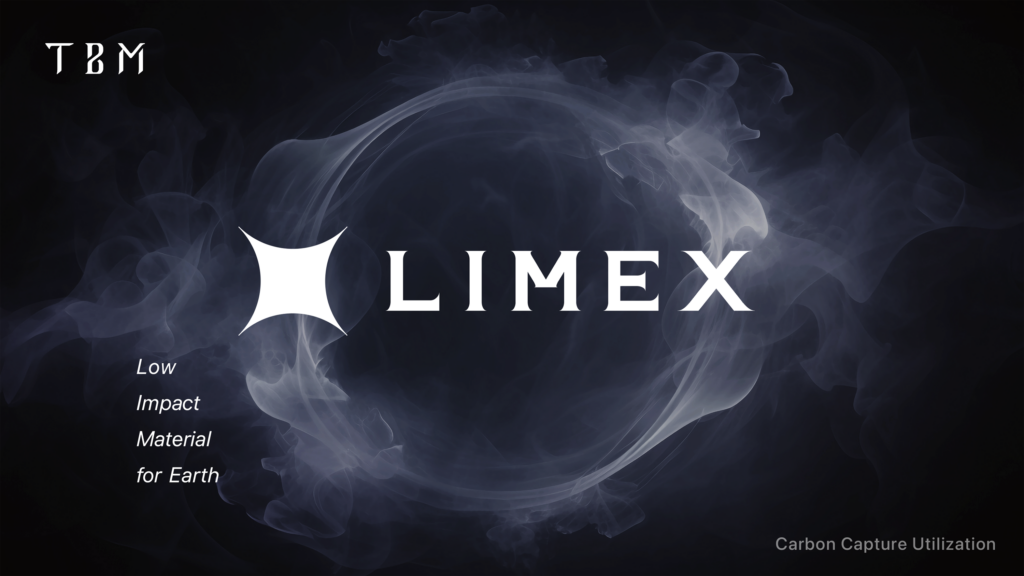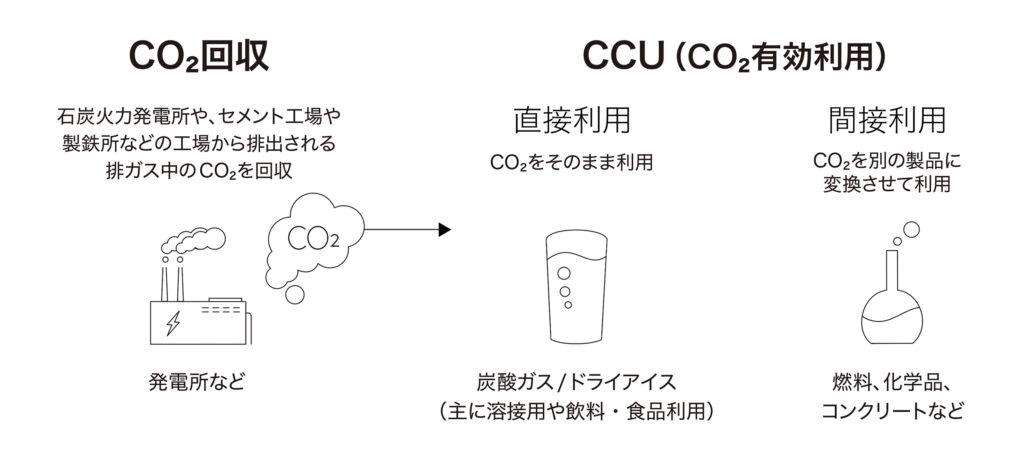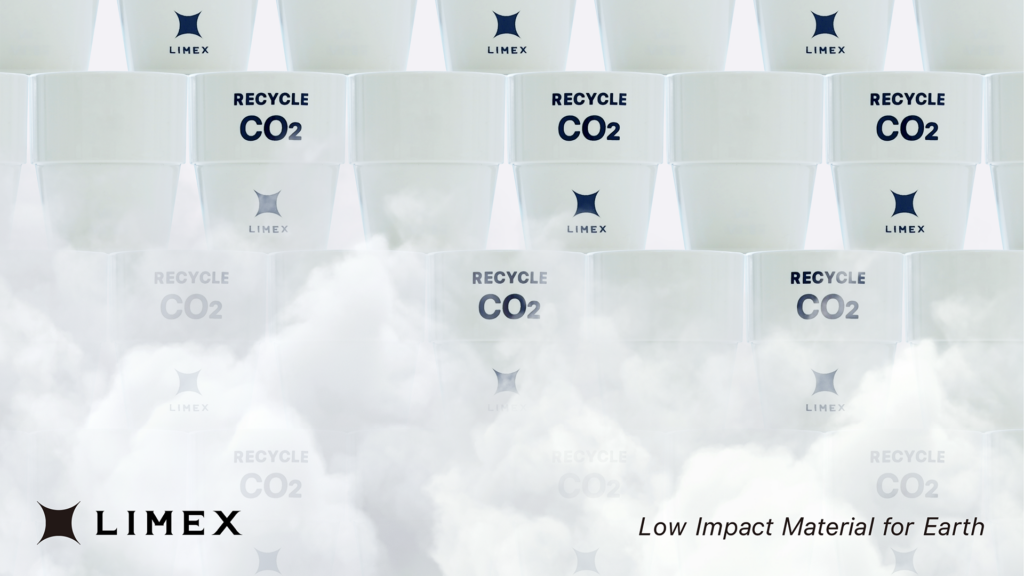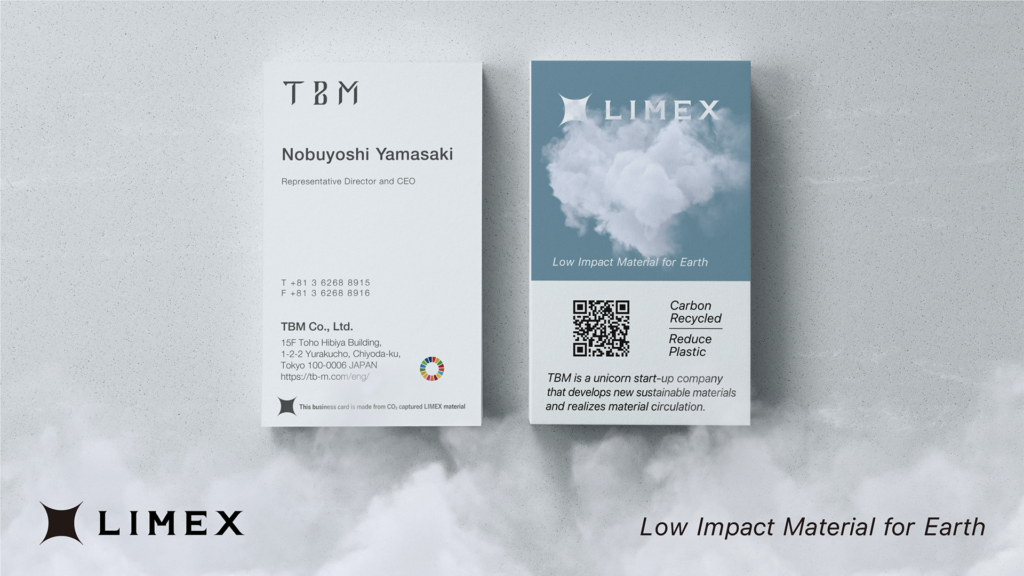プレスリリース
- LIMEX
ダボス会議にてカーボンリサイクル技術による低炭素素材「次世代 LIMEX」を発表
~排ガス由来の CO2 を回収・再利用し、カルシウム含有廃棄物を合成した炭酸カルシウムを主原料に活用~

株式会社TBM(本社:東京都代田区、代表取締役CEO:山﨑敦義、以下TBM)は、スイス東部のダボスで開催された世界経済フォーラムの年次総会(ダボス会議、2024年1月15日~19日)にて、カーボンリサイクル技術を使用した「次世代LIMEX*」を発表しました。
排出されるCO2を分離・回収し、多様な炭素化合物として再利用するカーボンリサイクル技術は、大気中へのCO2の排出を抑える重要な技術の1つとして、国内外で注目されています。次世代LIMEXは、石灰石を主原料とする従来のLIMEXで使用されていた鉱物由来の炭酸カルシウムを、排ガス由来の CO₂と、コンクリートスラッジや鉄鋼スラグなど工場から排出されるカルシウム含有廃棄物から、低環境負荷のプロセスで化学合成した炭酸カルシウムに置き換えることで、カーボンニュートラルへの貢献を推進する低炭素素材です。
*次世代LIMEXも従来のLIMEX 素材の定義と同様に炭酸カルシウムなどの無機物を 50%以上含む、無機フィラー分散系の複合素材に該当します。
次世代LIMEXについて詳細はこちら:https://tb-m.com/business/limex2.0/
背景
カーボンリサイクルの脱炭素への巨大なインパクト
IEAの予測では、エネルギー起源のCO₂排出のうち、カーボンリサイクル技術を含むCCUS(Carbon Capture, Usage and Storage:CO2の回収・貯留)に期待される削減貢献量は約19%でトップ3に入っています*1。カーボンリサイクル技術の普及は、カーボンニュートラルの社会づくりに大きく貢献できると期待されています。
急成長するカーボンリサイクルの世界市場
ICEFの予測では、カーボンリサイクル技術を使ってCO₂を原料として作る製品の市場規模は、2025年に2,975億ドル(約40兆円)、2030年に8,370億ドル(約120兆円)まで成長しうると言われています*2。
日本政府によるカーボンリサイクル技術の推進
日本政府でも2050年のカーボンニュートラル目標の実現に向けて、2023年に「カーボンリサイクルロードマップ」を策定し、カーボンリサイクルの一層の普及促進を掲げています。カーボンリサイクル技術による、2050年時点での最大CO2リサイクル量(国内利用されるカーボンリサイクル製品相当)を、最大で約1~2億トンと試算されています*3。
*1IEA “Energy Technology Perspectives 2020”
*2The Innovation for Cool Earth Forum (ICEF); Carbon Dioxide Utilizaiton (CO2U) – ICEF ROADMAP 1.0、1ドル=140円と仮定*3経済産業省 資源エネルギー庁「カーボンリサイクルロードマップ」

次世代LIMEX の概要
従来のLIMEXは、豊富で枯渇リスクの少ない石灰石由来の炭酸カルシウムを使うことで、石油由来のプラスチックの使用量やライフサイクル全体でCO₂排出量を減らせるプラスチックの代替素材として、また、水の消費量を減らせる紙の代替素材として、既に10,000以上(事業所数含む)の企業や自治体等に採用されています。
今回発表した次世代LIMEXは、石灰石由来の炭酸カルシウムに代わり、排ガス由来のCO₂と、工場から排出されるカルシウム含有廃棄物を低環境負荷のプロセスで化学合成した、カーボンネガティブ*が見込まれる炭酸カルシウムを主原料としています。次世代LIMEXの開発にあたっては、NEDOの「地域に眠る技術シーズやエネルギー・環境分野の技術シーズ等を活用したスタートアップの事業化促進事業」に採択され、また、東北大学とも共同研究を実施してきました。この度、世界経済フォーラムの「Unicorn Community (ユニコーン・コミュニティ)」の一員として参加したダボス会議にて、次世代LIMEX のプロトタイプとなる射出成形製品や、シート製品の試作品を発表しました。
今後TBMは、今回発表した次世代LIMEXの量産を目指すと同時に、副原料である樹脂部分を従来の石油由来のものではなく、植物由来の樹脂やリサイクル樹脂を使うことで、さらに環境負荷を低減した素材の開発を推進していきます。
*経済活動による温室効果ガス排出量よりも、除去・吸収される温室効果ガスの量が多い状態。



特徴
LIMEXに適する炭酸カルシウムの制御技術
カーボンリサイクル技術を使って化学合成した炭酸カルシウムは、LIMEXに適する粒子形状やサイズにデザインし、コントロールすることが重要になります。TBMでは、LIMEXの開発を通じて、世界40ヵ国以上で 200 件以上の特許が登録されています。カーボンリサイクル技術を使用した素材開発についても既に国内特許を取得しています。
付加価値の高い、幅広い用途へ対応
カーボンリサイクルで炭酸カルシウムの用途は、従来はセメントや骨材が主に考えられていました。次世代LIMEXは、産業用フィルムや食品パッケージ、ラベル基材など、産業資材から身近な消費財まで、従来のLIMEXと同様に付加価値が高い様々な用途に使用することが可能です。
カーボンリサイクルによる環境性能
カーボンリサイクル技術を使って大気や排ガス由来のCO2を吸収・固定して作る炭酸カルシウムを主原料にすることで、プラスチック代替品を製造する際、従来の石油由来のプラスチック製品と比較して、石油由来プラスチックの使用量や、ライフサイクル全体でのCO2排出量を減らすことが可能です。さらに、CO2を固定したまま、繰り返しリサイクルすることが可能です。なお、カルシウム含有廃棄物を素材の原料に使用することで、再生利用による資源の有効活用にも寄与します。
ブランドロゴ
全体フォルムをXとし「無限の可能性を持っている」という今のLIMEX を継承し、日本発の環境配慮型新素材として、さらに進化したLIMEXとしてブランディングを推進していきます。人が暮らす地球環境維持の為に、新たな化学合成技術も取り込み、LIMEXのLIMEの意味合いも「Low Impact Material for Earth」へと進化していきます。

